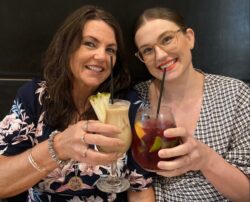Michelle Hayton (left) donated her womb to her daughter Kirsty Bryant (right)
An Australian woman hopes to carry a baby in the same womb she was grown in following a transplant from her mother.
Kirsty Bryant became the first woman in the country to receive a uterine transplant following mammoth operations for both her and her mother Michelle Hayton, 54, at the Royal Hospital for Women in Sydney last month. Bryant, 30, was unable to carry children following an emergency hysterectomy after the birth of her daughter, Violet, two years ago.
Bryant and Hayton shared their story on channel Nine’s 60 Minutes.
‘Kirsty rang, she said to me, “Hi, Mum. What do you think about having a hysterectomy and giving me your uterus?”,’ recalls Hayton. ‘I said, “Yep it’s on. I have no problem with that”.’
Hayton spent 11 hours in the operating theatre as surgeons worked to remove her uterus from the many surrounding organs and vessels.
Professor Mats Brannstrom, who performed the world’s first womb transplant resulting in a child in 2014, led the two operations.
‘There are small blood vessels going out, and we try to isolate those,’ he said. ‘The problem is that there is a ureter on each side. And the ureter goes from the kidney to the bladder, and we cannot injure that.’
After removal, the uterus was flushed out before being transplanted into Bryant, who now hopes to carry another child in the donor womb.
‘I am going to potentially, all fingers and toes crossed, carry a baby in the same uterus, in the same womb I was growing in,’ Bryant said. ‘It will hopefully be a great story to tell my baby one day.’
Dr Rebecca Deans, the trial’s lead surgeon, said she ‘couldn’t have been happier’ with how the surgeries went.
‘It was such a wonderful day to actually finally get there and be in that room,’ she said. ‘The buzz was amazing. And then it all went to plan, and Kirsty’s doing beautifully.’
Hayton and Bryant hug before their surgeries (Picture: Sylvia Jeffreys/Facebook)
The operation’s success also marks a huge breakthrough in Australian fertility treatment.
‘Personally, professionally, it was just incredible, and I think everyone felt the same,’ Deans said. ‘There were so many components to the team, the nursing staff, the anaesthetists and everyone’s saying that they felt the same way, that they really felt like it was one of those moments you’ll reflect on professionally and never ever forget.’
Less than two months on from the operation, Hayton has yet to regain feeling in her bladder and suffered a serious infection following the surgery, but says she has no regrets.
For Bryant, it will take a little while longer to see if she can carry a baby. However, six embryos are ready and waiting for transfer.
‘It could be somewhere between three and six months from the surgery where we can start implanting those embryos,’ said Deans. ‘And each of those embryos has a 30 to 50 per cent chance of success.’
A recent study showed that of the women who received womb transplants in the US between 2016 and 2021, more than half went on to have successful pregnancies, with 19 of 33 women delivering 21 babies. Babies have now also been born from the wombs of deceased patients, rather than live donors.
Professor Brannstrom previously carried out a similar procedure on a mother and daughter in Sweden, resulting in a healthy baby boy.
And while there are no guarantees for Bryant, she remains sure of the positives in having the surgery.
‘To not put my hand up and give it a go, I think would be a massive regret for myself,’ she said. ‘Even if it doesn’t go to plan, the research and the information that they will get from this, in Australia, is going to be worth it.
‘I just want to give hope and give options for other women out there.’
MORE : Woman discovers she was born without a developed womb
MORE : Mum born with two wombs gives birth to twins with different skin tones
The pair underwent mammoth operations.





